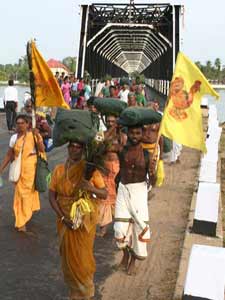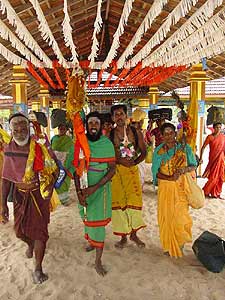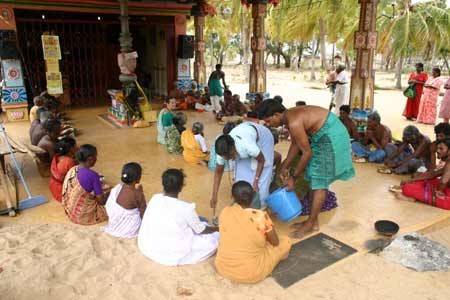
|
||||||||||||||
|
| ||||||||||||||
 2006 Kataragama Pada Yatra pilgrims brave adversity
(COLOMBO) The Living Heritage Trust today released details on the annual Kataragama Pada Yatra or coastal foot pilgrimage to God Skanda's shrine in the far South. Ardent devotees from northern and eastern districts assembled in late June at Verugal Kataragama Devale on the Trincomalee-Batticaloa district border, said Living Heritage Chairman Manik Sandrasagra. On 26 June they recited their vows and headed South, echoing the pilgrims' spirited cry of ‘Haro Hara!' all their way to Kataragama. The month long trek will reach Kataragama on 26 July to coincide with the Esala Festival flag hoisting ceremony. RefugeesThe Pada Yatra this year started from the famous Murugan temple at Verugal, rather than from Jaffna or Mullaitivu or Trincomalee as in years past, due to mass evacuation of villagers from Mutur vicinity. At Verugal alone some 700 villagers are living in tents as refugees. For many the Pada Yatra is a priceless opportunity to visit and worship ancient remote shrines in the company of veteran devotees. Their long trek takes them via Verugal and Kathiraveli to famous ancient temples at Sittandy, Mamangam, Kokkatichcholai and Mandur in Batticaloa District. Through Ampara District they follow the coast via Pottuvil and Okanda through Yala National Park to reach the Kataragama Sacred City in time for the Esala Festival flag-hoisting. Since 1988 the Living Heritage affiliated Kataragama Devotees Trust has annually organized the Pada Yatra by notifying societies and temples all along the East Coast. This facilitates dana, the ritual offering of food and hospitality, which is essential to the pilgrims, since most are poor and none can carry food for weeks. All along the route, villagers await their chance to offer annadanam to the growing bands of pilgrims, who are mostly in their 50's, 60's and 70's—and a few even in their 90's. Some pilgrims may be seen carrying the God's bright red and yellow cock banner. Others wave peacock feathers, while senior swamis bear aloft the vel or lance, symbol of the God's invincibility. Even small children dressed in vetti may be heard shouting ‘Haro Hara!' (‘Hallelujah') and joining in the constant recital of bhajanas in praise of God Kataragama. Traditional dressTraditional pilgrims wear authentic pilgrim's dress only: vettis and shawl for men, saris for women. Trousers, shirts, or shoes are considered unacceptable dress for pilgrims. Pilgrims sleep out of doors at night or in temples, but not in private homes. Elder pilgrims especially enjoy the respect of villagers and pilgrims alike, who consider them as treasuries of age-old oral traditions. Consumption of alcohol is strictly prohibited. Many villagers take vows to join the Pada Yatra as it passes through their own village, so the parties of pilgrims tend to grow as they proceed from village to village. With weeks still remaining before the flag-hoisting ceremony on 26 July, hundreds of pilgrims are expected to join or follow the bands of pilgrims as they pass through Batticaloa and Ampara districts. RevivalThe age-old tradition of Pada Yatra fell into abeyance with the 1983 civil disturbances but was revived in 1988 under Kataragama Devotees Trust patronage. The number of pilgrims has grown steadily ever since. In 2004 Wildlife Dept officials counted over 30,000 pilgrims entering Yala East National Park on the final 100-kilometre stretch before Kataragama. Living Heritage also develops a website for Kataragama devotees at www.Kataragama.org, whose popularity continues to grow. Even the Pada Yatra now has its own website at www.PadaYatra.org. "We are a network of devotees from all over the world," says Sandrasagra, noting that the popular website also plays a role in attracting foreign devotees and international media, including The Discovery Channel. Even today in neighboring countries like India, religious processions and pilgrimages are sources of communal friction and even violence. But the Kataragama Pada Yatra is actually a source of consensus and communal harmony, a fact that Sri Lankans may rightly reflect upon and be grateful for. For more information about Living Heritage visit www.LivingHeritage.org Enquiries by e-mail: info@padayatra.org Pada Yatra 1997 | Pada Yatra 1999 | Pada Yatra 2000 | Pada Yatra 2001 | Pada Yatra 2002 | Kataragama Devotees Trust | 2006 Pada Yatra Report No. 2 | 2005 Pada Yatra Photo Gallery I | 2005 Pada Yatra Photo Gallery II | www.Kataragama.org
|



